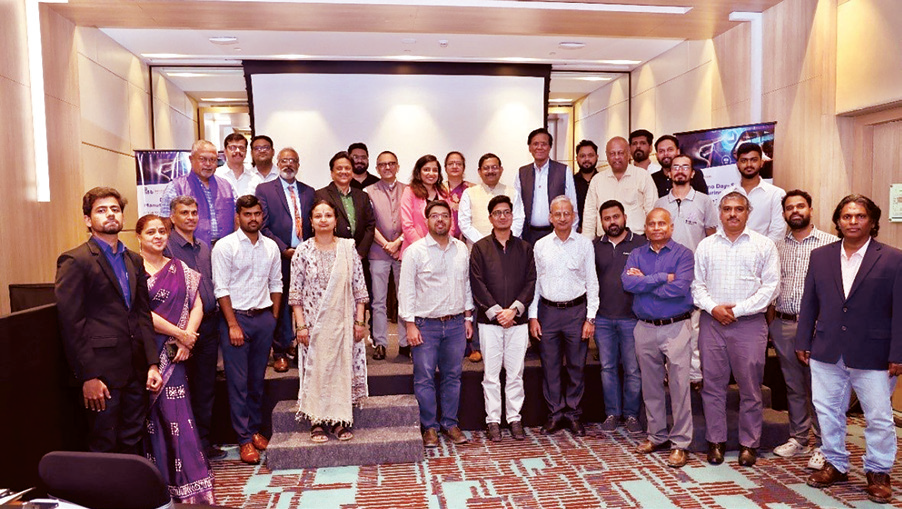
Capturing the invisible: The comic book follows the story of a building from a barren site to a finished structure
By Falah Faisal
As Rafik and Mehboob sit at the dais in the Alliance Francaise auditorium, they are smiling from ear to ear overwhelmed with emotion. What they thought was an innocent interaction with a friendly foreigner five years ago has been turned into a graphic novel. Something they could have never imagined in their wildest dreams, has led them here.
But we are getting ahead of ourselves. Let’s dial it back a little.
I first meet Simon Lamouret at Champaca, a quaint little bookstore just off Queens Road. He is here to have an interaction with Amitabh Kumar, a mural artist and comic book writer, to promote his latest graphic novel, “The Alcazar”. It’s his second book set in the city. How does a French writer from Toulouse come to write about Bengaluru you wonder? Like everything, it happened by chance.
“When I was younger and more carefree, I always had the fantasy of just dropping everything and taking off to a place I knew nothing about,” Simon explains. “That’s how I found myself in Delhi in 2013. I met a person there who was starting an art school and he offered me a job in Bengaluru. When I moved here, I knew nothing about the city and it went on to be my home for the next five years,” says Simon.
Alcazar means a Spanish palace or fortress of Moorish design. But this one refers a building on Hutchins Road. Coincidentally, Amitabh, had once been to see a house in that very building. “It was 2 BHK and the rent they were asking for was 54 thousand. Now if they find out that there is a graphic novel about it, they might ask for 60.”
The book follows the story of the building from a barren site to its construction through to its completion and tells the story of the people who worked on it and guarded it.
An odd topic for a book. But how did it begin. “I was teaching at an architecture college in Bengaluru and I knew I wanted to do something about construction sites,” Simon explains.
Because that is the invisible part about any city. When I asked my friends they were mostly ignorant about life on a construction side. There are misconceptions and stereotypes, like they think all the workers are Bihari, they are alcoholic and have a bad reputation.”
Simon and Mansi Kashatria (his translator and coresearcher) rode all across the city looking for construction sites and couldn’t find any that were suitable until one day they realised there was one just down the road from where Simon lived. “Sometimes when something is right in front of you, you take it for granted and don’t see it. Until it hits you right in the face. The site was just starting to be built and was perfect for the kind of project I had in mind,” says Simon.
He started visiting the site every day for the next seven months drawing and speaking to the workers with the aid of Mansi. “I didn’t ask for permission, because in India asking for permission is exposing yourself to rejection. I just showed up and started drawing and the workers got curious. The head of construction came to speak to me and I told him I’m an architecture student interested in studying Indian construction techniques. He was very enthusiastic and opened the doors for me,” Simon explains. And that is how he met the lead characters of his book Mehboob and Rafik.
“Even though my name is on the book, I can’t take sole credit for it. It was a collaborative effort by the workers who opened up their live stories to us, Mansi without whose translation the book wouldn’t be possible and Bhoomika who chipped in when Mansi was not available,” he says.
A staple of the genre of non-fiction comics is where the writer inserts himself into the story as a character, something Simon doesn’t do in Alcazar. “It was already a mistake I had made in my last book and didn’t want to do it again. Also, I felt that it would have been obscene to make the story about me. I wanted to represent the lives of the workers as truly as possible.”
“I only fictionalised parts that seemed plausible. Otherwise a lot of interesting anecdotes would have been lost had I just stuck to the parts I’d seen,” says Simon.
He believes that there is no pure non-fiction and fiction, he explains “Even a documentary has parts that are staged and fictionalised. And a fiction story -- even something as wild as fantasy or science fiction -- has some basis in reality. Drawing comics isn’t about showing off your techniques but telling a good story. Both what you say and how you say it are equally important.” He cites Charles B u r n s a n d Chris Ware as his influences.
What is different about drawing India, according to him? “The most difficult th
 English daily published in Bengaluru & Doha
English daily published in Bengaluru & Doha






